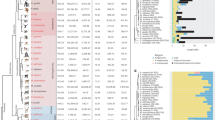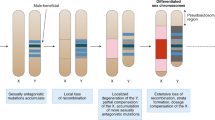Abstract
IN mammals, induction of male sex determination requires the Y-chromosome gene SRY1. SRY encodes a protein with a central 'high mobility group' domain (HMG box) of about 78 amino acids1–3. HMG boxes are found in a wide variety of proteins that bind to DNA with high affinity but differing degrees of sequence specificity4. The human SRY protein binds to linear DNA with sequence specificity5 and to cruciform DNA structures without sequence specificity6. The DNA-binding activity of the SRY protein resides in the HMG box and mutations in this region are associated with sex reversal in XY females6–8. No function has been ascribed to the portions of the SRY protein outside the HMG box. SRY belongs to a family of genes that are related by sequence homology within the DNA-binding domain: the genes most similar to SRY (>60%) have been named SOX genes (SRY box genes). None of the known SOX genes is homologous to SRY outside the HMG-box region. Although SRY is an important developmental regulator, its sequence is poorly conserved between species apart from the HMG-box domain. Here we investigate the coding sequence of SRY in primates and find that evolution has been rapid in the regions flanking the conserved domain. The high degree of sequence divergence and the frequency of non-synonymous mutations suggest either that the majority of the coding sequence has no functional significance or that directional selection has occurred.
This is a preview of subscription content, access via your institution
Access options
Similar content being viewed by others
References
Sinclair, A. H. et al. Nature 346, 240–244 (1990).
Su, H. & Lau, Y.-F. C. Am. J. Hum. Genet. 52, 24–38 (1993).
Gubbay, J. et al. Nature 346, 245–250 (1990).
Ner, S. S. Curr. Biol. 2, 208–210 (1992).
Harley, V. R. et al. Science 255, 453–456 (1992).
Ferrari, S. et al. EMBO J. 11, 4497–4506 (1992).
Berta, P. et al. Nature 348, 448–450 (1990).
Jager, R. J., Anvret, M., Hall, K. & Scherer, G. Nature 348, 452–454 (1990).
Gubbay, J. et al. Proc. natn. Acad. Sci. U.S.A. 89, 7953–7957 (1992).
Li, W. H., Wu, C. I. & Luo, C. C. Molec. Biol. Evol. 2, 150–174 (1985).
Koopman, P., Gubbay, J., Collignon, J. & Lovell-Badge, R. Nature 342, 940–942 (1989).
Palmer, M. S., Berta, P., Sinclair, A. H., Pym, B. & Goodfellow, P. N. Proc. natn. Acad. Sci. U.S.A. 87, 1681–1685 (1990).
Hill, R. E. & Hastie, N. D. Nature 326, 96–99 (1987).
Hughes, A. L. & Nei, M. Nature 335, 167–170 (1988).
Hughes, A. L., Ota, T. & Nei, M. Molec. Biol. Evol. 7, 515–524 (1990).
Hughes, A. L. Genetics 127, 345–353 (1991).
Malaspina, P. et al. Ann. hum. Genet. 54, 297–305 (1990).
Ellis, N. et al. Nature 344, 663–665 (1990).
Foster, J. W. et al. Nature 359, 531–533 (1992).
GCG Program Manual for the GCG Package (575 Science Drive, Madison, Wisconsin 53711, USA, 1991).
Johns, M. B. & Paulus-Thomas, J. E. Analyt. Biochem. 180, 276–278 (1989).
Felsenstein, J. Cladistics 5, 164–166 (1989).
Author information
Authors and Affiliations
Rights and permissions
About this article
Cite this article
Whitfield, L., Lovell-Badge, R. & Goodfellow, P. Rapid sequence evolution of the mammalian sex-determining gene SRY. Nature 364, 713–715 (1993). https://doi.org/10.1038/364713a0
Received:
Accepted:
Issue Date:
DOI: https://doi.org/10.1038/364713a0
This article is cited by
-
Evolutionary dynamics and conserved function of the Tudor domain-containing (TDRD) proteins in teleost fish
Marine Life Science & Technology (2022)
-
Mutations in disordered proteins as early indicators of nucleic acid changes triggering speciation
Scientific Reports (2020)
-
Genetic assessment of an isolated endemic Samango monkey (Cercopithecus albogularis labiatus) population in the Amathole Mountains, Eastern Cape Province, South Africa
Primates (2018)
-
Reduced Activity of SRY and its Target Enhancer Sox9-TESCO in a Mouse Species with X*Y Sex Reversal
Scientific Reports (2017)
-
To be disordered or not to be disordered: is that still a question for proteins in the cell?
Cellular and Molecular Life Sciences (2017)
Comments
By submitting a comment you agree to abide by our Terms and Community Guidelines. If you find something abusive or that does not comply with our terms or guidelines please flag it as inappropriate.



